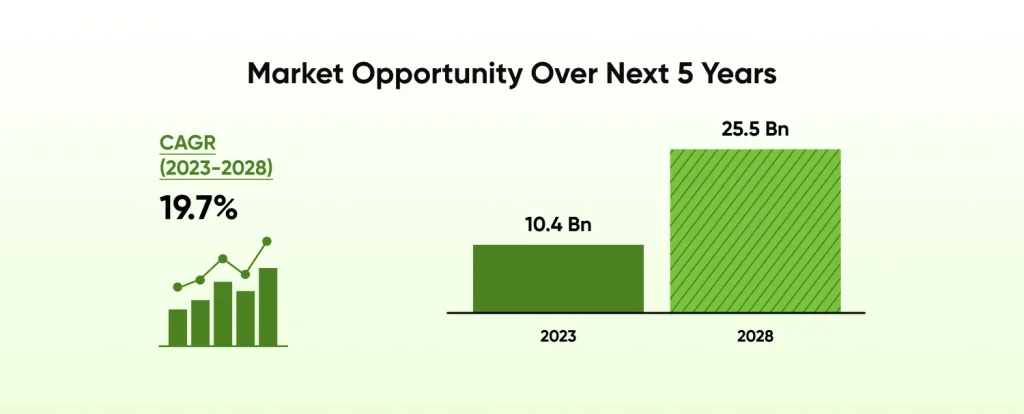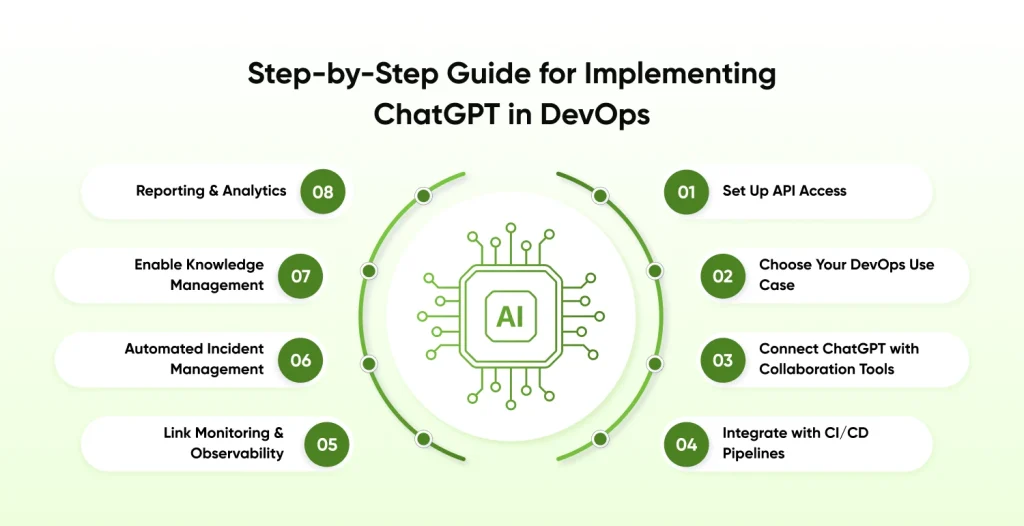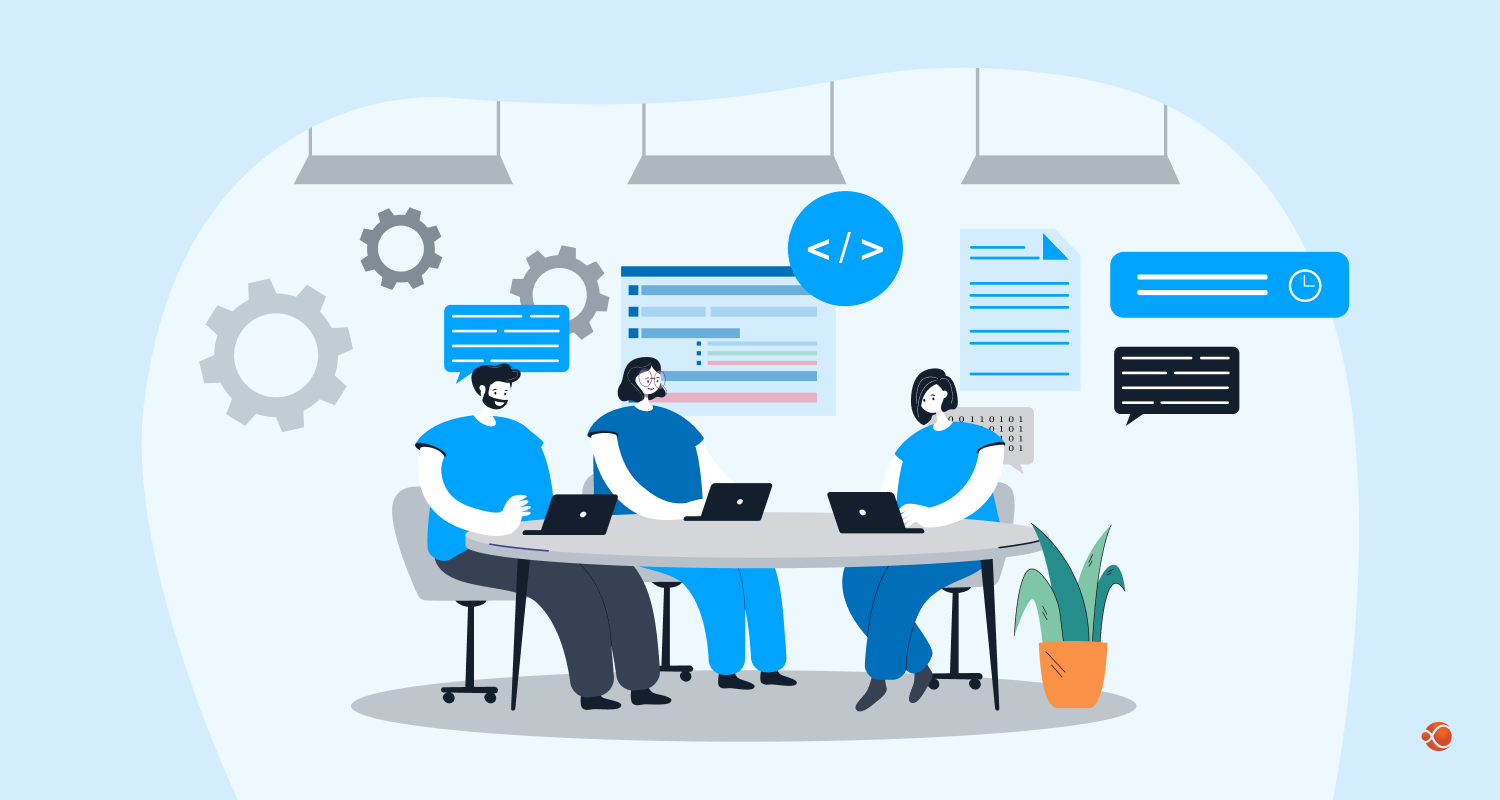Quick Summary: Transform the DevOps pipeline with ChatGPT for DevOps automation in 2026, where breakthrough AI-driven efficiency meets unparalleled speed. Discover how to automate repetitive tasks, slash incident resolution times, and unlock predictive insights that keep your systems ahead of the curve. This is your pathway to innovate faster, dominate your market, and boost reliability.
The world of software development has changed recently. The slow, manual processes that once defined our work are now being replaced by something faster, smarter, and more efficient.

The DevOps market size was valued at USD 10.4 billion in 2023, driven by AI and automation, and it is expected to grow at a CAGR of 19.7% from 2023 to 2028. Also, the revenue forecast for 2028 is projected to reach $25.5 billion. If you’re a DevOps engineer, a tech leader, or a developer, you’re either already using generative AI to streamline your tasks or you’re about to be left behind.
This blog will provide you with insights about the practical steps of how to use ChatGPT for DevOps automation and why it’s the most important skill to have in your toolkit today.
The Evolution of DevOps in the AI Era
DevOps was born from the need to break the silos and create a culture of speed and collaboration. The primary focus is on infrastructure as code (IaC) and continuous integration, continuous delivery (CI/CD). But even with these practices, a lot of manual repetitive work remained.
The evolution that we are witnessing is the integration of intelligent systems into every stage of the software lifecycle. We are moving from simply automating the tasks to building intelligent pipelines that can learn, adapt, predict, and even self-heal. And this isn’t just about a chatbot; it’s about a complete fundamental shift to tools like ChatGPT.
What Is Generative AI/ChatGPT?
At its core, Generative AI is a type of AI that can create original content. Unlike a simple program that follows a set of rules, it learns from huge datasets and then generates new text, images, or code that is unique and contextually relevant.
ChatGPT is a prime example of this technology. It’s a large language model that is designed to understand and generate human language.
Its ability to process natural language means you give it simple instructions, and it can translate into a complex, technical output. For DevOps teams, this is a revolutionary capability. It transforms your ability to communicate with your tools, making them more powerful and intuitive than before. Whether you’re working with internal teams or considering DevOps outsourcing options, this AI integration represents a complete shift in how we approach infrastructure management.
Why Is Generative AI for DevOps Essential Now?
The timing of this technology breakthrough is no longer a coincidence. Three key factors have converged to make this the right time for generative AI solutions in DevOps:
- Scale: Modern applications are very complex. We’re talking about thousands of microservices, each with its own dependencies, running on multi-cloud infrastructure. The sheer scale is too much for humans to manage manually.
- Complexity: The technology stack is constantly evolving. From Kubernetes to serverless functions, the knowledge required for managing modern environments is immense. AI helps in reducing the complexity by automating and generating scripts and configurations.
- Demand: Downtime and slow deployment are no longer acceptable. The market demand is for faster feature release and a flawless user experience. The only way to reach this efficiency is through a new level of automation that is both reliable and intelligent.
Whether your company is building its own AI software or looking at external DevOps consulting services to get a fresh start, the drivers are the same. This technology is no longer a “nice to have”, it’s a strategic step.
Key Benefits of Using Generative AI for DevOps
Implementing DevOps Automation with ChatGPT isn’t about adopting a fancy tool; it’s about achieving tangible business benefits.
Automating Repetitive Tasks
This is the most crucial benefit of AI. Think of the time spent in creating units, writing shell scripts, and configuring CI/CD steps. When you automate with ChatGPT, you can simply describe what you want, and the AI will generate the code, allowing engineers to focus on high-value tasks.
Enhancing Error Detection and Faster Troubleshooting
When the development production goes down, every minute costs money. But generative AI can analyze a vast amount of data logs, pinpoint the error, and even suggest a fix in minutes. This ability to quickly process and understand unstructured data is what makes AI DevOps automation a game-changer for incident response.
Accelerating Onboarding and Knowledge Transfer
An AI can act as a personal tutor, explaining complex systems, summarizing legacy codebases, and generating documentation. The need to quickly onboard a new team member is a prime opportunity to hire AI developer who can build tools to accelerate the process, freeing up the rest of the team to focus on high-impact work immediately.
Optimizing Cost and Resource Usage
Generative AI can analyze cloud spend and suggest optimizations. It can look at usage patterns and recommend changes to instance types or scaling rules, which directly helps you in reducing your cloud bill.
Delivering Predictive Insights
AI in DevOps is moving just beyond being reactive by analyzing a continuous stream of data from monitoring tools. An AI tool can predict potential issues, such as the server running out of memory, and alert the team before a service is impacted.
Improving Consistency and Standardization
The developers’ team sometimes struggles with code that doesn’t follow a certain standard or configuration that drifts from the desired state. AI can enforce these rules automatically and make sure that every piece of code and infrastructure adheres to the company’s policies. This is an important element of modern DevOps best practices.
How ChatGPT Fits into DevOps Workflows
The real power of this technology lies in its ability to integrate smoothly with existing tools and processes.
Where it Applies in the Pipeline:
- Design: Generating architectural diagrams and markdown-based documentation by just writing a simple prompt.
- Development: Assisting with scaffolding new code, writing new functions, and suggesting improvements during development.
- Testing: Automatically generating integration tests and mock data.
- Deployment: Creating deployment manifests for Terraform or Kubernetes.
- Operations: Analyzing and summarizing logs and automating responses to common alerts.
Interaction Models:
- Support Agent: The most common model, where an engineer asks the AI for help via a chat or command-line interface.
- Automation Agent: The AI, based on a predefined set of rules, takes actions on its own. For example, a bot that automatically rolls back a faulty deployment.
- Human-in-Loop: The artificial intelligence provides a suggested action, but a human must approve it before it is executed. This is the safest approach for critical operations.
Integration Touchpoints:
Implementing ChatGPT in DevOps means connecting it to tools you already use. This can be done through:
- Git: An AI bot can automatically add comments to pull requests, suggesting improvements and pointing out bugs.
- CI/CD Tools: Custom plugins or API calls can use AI to check build logs for errors or generate a release changelog.
- IaC (Infrastructure as Code) platforms: The tools can use AI to generate and validate Terraform and Ansible manifests.
- Ticketing system: An artificial intelligence agent can automatically update incident tickets with a summary of the problem and potential solutions.
Role in DevSecOps:
Security is now a main part of the DevOps process. AI can help scan code automatically for vulnerabilities, check infrastructure configuration against security policies, and even help to write secure code from the start.
Human Oversight:
No matter how advanced the AI will become, human oversight will remain critical. The engineer is the final decision-maker. You must review and approve all AI-generated code and configurations, especially for production systems.

Best Practices for Using ChatGPT in DevOps Automation
To get the most value from these tools and avoid potential pitfalls, follow these best practices to automate DevOps tasks with AI.
Prompt Engineering
The quality of the AI response is directly related to the prompt quality. Be specific, provide context, and use examples. This is a skill in itself. For example, instead of “write a script”, use a detailed prompt that includes the language, the goal, and any specific constraints.
Version Control, Auditing & Reviewing AI-Generated Code/Configs
Treat AI-generated code just like human-written code. It must be checked in your Git, and it should go through your standard review process. This creates an audit trail and ensures quality.
Security Practices
This is the most important thing: never put sensitive information, like API keys and passwords, into a public AI tool. Use private models or ensure your integration can handle secrets securely through dedicated management systems.
Monitoring and Feedback Loops
Set up monitoring to track the performance of your Artificial Intelligence automation. Measure the time saved and the accuracy of the output. If you notice a model providing inaccurate or incorrect suggestions, you need to give feedback to help it improve.
Governance
Create precise guidelines for using AI. Who owns the models? What’s the process of change management? Who reviews the AI-generated code? These are all questions that are used to answer for a smooth transition.
Ethical Compliance and Consideration
Be aware of any potential biases in the models. Make sure that the data used for training and the output generated comply with the data privacy regulations. This is specifically important for any AI model fine-tuning development services you might use.
Step-by-Step Guide for Implementing ChatGPT in DevOps

The power of generating AI is unlocked not just by using it in isolation, but by deeply embedding it within the tools and platforms your teams use every day. Here are the practical step-by-step instructions for the smooth integration of ChatGPT into your DevOps environment.
Step 1: Set Up API Access
Before you can connect anything, you need to secure a way for tools to communicate with the AI model.
- Register and Obtain Your API Key: Sign up with OpenAI or your chosen enterprise AI provider. This will give you access to their APIs.
- Store Credentials Securely: Never hardcode API keys or credentials in your scripts. Use a dedicated secrets management tool like HashiCorp Vault, Azure Key Vault, or AWS Secrets Manager to store these securely. Your applications and services can then retrieve the keys at runtime.
Step 2: Choose Your DevOps Use Case
Don’t try to automate everything at once. Start with a single, high-impact use case to prove the value and refine your process.
- Build Notifications in CI/CD Pipelines: A simple, low-risk starting point. The AI can summarize build logs and post a clean, actionable message to a chat channel.
- Automated Incident Triage & Root Cause Suggestions: A high-impact use case that can dramatically reduce Mean Time to Resolution (MTTR).
- Monitoring Queries in Natural Language: Allows team members to ask simple questions about system health without needing to know a complex query language.
- Knowledge Assistant for Jira or Confluence: A great way to speed up onboarding and knowledge transfer.
Step 3: Connect ChatGPT with Collaboration Tools
Many DevOps workflows begin and end in a team chat. Integrating ChatGPT here makes it easily accessible and intuitive.
- Slack/MS Teams: Use the bots framework or official API for your platform.
- Configuration: Configure a custom bot to listen for specific commands or mentions. For example, “@ChatGPT” could be a trigger, or you can use a slash command like “/deploy.”
- Example in Action: You could type: “@ChatGPT, show me the last 5 failed builds in Jenkins.” The bot, configured to know your Jenkins instance, will respond with a formatted list and direct links.
Step 4: Integrate with CI/CD Pipelines
This is where Automating CI/CD with ChatGPT truly comes to life.
- Create a Middleware Service: For robust integration, build a small service (in Node.js, Python and Go) that sits between your CI/CD tools (like Jenkins, GitLab CI, or GitHub Actions) and ChatGPT API. This service can handle authentication, prompt formatting and error handling.
- Webhook Triggers: Configure your CI/CD pipelines to send webhooks to your middleware service on specific events, for example, pull requests open and build failures.
- Natural language prompts: You can build human-readable commands that can trigger complex actions. For instance: “ChatGPT, trigger a hotfix deployment to staging for service-x from commit-1234.” The middleware service translates this into the necessary API calls to your CI/CD platform.
Step 5: Link Monitoring & Observability
AI in DevOps is most effective when it can access real-time data.
- Connect to APIs: Integrate ChatGPT with the APIs of your monitoring and observability platforms like Prometheus, Grafana, or Datadog.
- Example Queries: This allows you to ask questions in plain English, bypassing the need to learn a query language like PromQL or LogQL:
- “What was CPU usage across all production Kubernetes clusters in the last hour?”
- “Summarize the top 5 error logs from microservice-x between 2 PM and 3 PM today.”
- Visualizations: ChatGPT can even generate the raw query and provide a link to the Grafana dashboard with the data pre-populated, making it a great learning tool for your team.
Step 6: Automated Incident Management
This is a high-value use case for ChatGPT for DevOps automation
- Integrate with PaperDuty/ Opsgenie: Connect your AI agents to your incident management platform, so whenever a new alert is created, the agent will automatically analyze the associated data.
- Automated Summaries: ChatGPT can read the alert description and related logs to provide a clear, one-paragraph summary of the incident for responders.
- Remediation Suggestions: Based on common runbooks and historical data, the AI can suggest a few quick remediation steps.
- Smart Escalation: For important issues, the AI can be configured to automatically escalate the incident to the appropriate on-call teams.
Step 7: Enable Knowledge Management
Make your collective knowledge base a living, breathing resource.
- Connect to Internal Wikis: Use connectors to link ChatGPT to your internal wikis like Confluence or documentation sites. You can also create a website with ChatGPT to build custom documentation portals and knowledge bases that integrate directly with your DevOps toolchain.
- Leverage Embeddings: For more precise answers, use a vector database to store document embeddings. When you ask a question like, “How do I restart the payment service without downtime?”, the AI searches the database for contextually similar documents and provides a precise, sourced answer.
Step 8: Reporting & Analytics
End the week with automated reports that provide deep insights in seconds.
- Automate Weekly DevOps Reports: Instead of manually compiling data, create a prompt that pulls data from your various tools.
- Example: “Summarize last week’s deployments, including the number of successful and failed builds. Provide a breakdown of our top 3 most common build failures and a summary of our MTTR.” ChatGPT can then provide a concise, formatted report that is easy to read and share.
Practical Use Cases: ChatGPT in Action for DevOps Teams
This is where the theory becomes practice. Here are some of the real-world examples of how using ChatGPT for DevOps is already changing the game.
Incident Response & Root Cause Diagnostics
A service goes down. An AI-powered bot automatically gathers all relevant logs, metrics, and recent changes. Within minutes, it posts a summary in a team’s Slack channel: “The payments service is experiencing high latency due to a recent change in the database schema. The logs show a high number of N+1 queries.
Recommended Action: revert to the previous version and schedule a fix.” This can cut incident resolution time by hours.
Automated Code Reviews & Pull Request Assistance
An AI bot reviews every pull request and provides instant feedback on code quality, potential bugs, and security vulnerabilities. This leaves the human reviewer to focus on the high-level design and business logic, leading to faster and more thorough reviews.
Infrastructure Provisioning
Instead of manually writing a complex IaC file, an engineer uses a tool to prompt an AI: “Provision a new development environment in Azure with an App Service, a Cosmos DB database, and a Virtual Network.” The AI generates the required ARM templates and a deployment script, which the engineer can review and run.
Configuration Drift Detection & Enforcement
A tool monitors a production environment and compares its current state to the IaC files in Git. If a configuration change is made manually, the AI can detect the drift and either automatically revert it or create a ticket for an engineer to review.
DevSecOps
An AI is integrated into the CI/CD pipeline to check for common security issues. It can scan a Dockerfile for any vulnerabilities or a configuration file for OWASP risks before a service is deployed.
Cost Optimization & Performance Tuning
An artificial intelligence analyzes billing data and performance metrics to find opportunities to save money. It might suggest moving a specific workload to a different cloud region or using a cost-effective instance family.
Practical Prompts and Templates for DevOps Tasks
Here are some ChatGPT prompts for DevOps professionals that you can use immediately:
| Category | Sample Prompt / Template |
| Scaffolding IaC | “Generate a Terraform template for an AWS EC2 instance. It should be a t3.medium instance, running Ubuntu, and be placed in a private subnet with an attached security group that only allows inbound traffic on ports 22 and 80. Provide comments for each block of code.” |
| Troubleshooting / Debugging | “I am seeing a java.lang.OutOfMemoryError in my application logs. Here is the stack trace: [Paste stack trace]. Analyze this and suggest possible root causes and a few steps to debug it.” |
| Security / Compliance Checks | “Check this configuration file for common security vulnerabilities related to open ports and default credentials.” |
| Automating CI/CD Steps | “Write a Jenkinsfile for a multi-stage pipeline. The stages should be Build (build a Docker image), Test (run unit tests), and Deploy to a staging environment.” |
| Change Logs / Release Notes / Documentation | “Based on the following Git commit messages, draft a professional set of release notes for version 2.1.0, categorized by ‘New Features,’ ‘Bug Fixes,’ and ‘Improvements.” |
| Monitoring & Alert Summaries | “I just received an alert that my database CPU usage is at 95%. Based on the following metrics, summarize the potential issue and suggest a few immediate actions.” |
What’s Next: The Future of ChatGPT in DevOps
We are still in the early days of this transformation. Here’s what we can expect next.
Shift Towards Self-Healing DevOps
The focus will shift from simple automation to building self-healing systems. These systems will not only detect an issue but also automatically apply a fix and verify the result. This is where AI software development services will become more crucial, as they build custom solutions for organizations.
Role of ML/Ops + AI safety/reliability engineering
As AI takes on more important tasks, the need for robust MLOps and AI safety practices will become paramount. We need to make sure these models are transparent, reliable, and safe.
More Integration with Observability, AIOps, Real-Time Feedback Loops
The line between observability and AI will blur. AI will become a core part of monitoring platforms, providing predictive insights and automated remediation.
Governance, Model training, and Domain fine-tuning for Organizational Standards
Companies will fine-tune AI models on their proprietary codebases and data. This will create highly specialized models that are more accurate and efficient for their specific needs, a service that AI model fine-tuning development services will offer.
Ethical, Regulatory, and Sustainability (Green DevOps) Implications
As AI usage grows, so will the ethical and regulatory questions. We will also need to consider the sustainability of running these large models, leading to a new focus on “green DevOps.”
The Evolving Role of DevOps Engineers
The role is not going away; it’s simply evolving. The DevOps engineer of the future will be less of a manual scripter and more of an AI trainer, architect, and auditor. They will be responsible for designing the systems that use AI and ensuring they operate safely and efficiently. This is a great area for DevOps outsourcing as well.
How CMARIX Can Help You Implement This Transformation
CMARIX is a leader in DevOps Consulting Services and generative AI solutions, with a proven track record of helping businesses integrate intelligent automation. We provide a complete approach that covers strategy, development, and support. Their expertise goes beyond a simple implementation. Here’s how CMARIX can speed up your DevOps transformation:
Deep Integration
Our development team can smoothly integrate AI agents and APIs into your existing DevOps toolchain. CMARIX builds the necessary connectors to link your CI/CD pipelines, monitoring, and incident management systems with generative AI, regardless of your tech stack.
Custom AI Solutions
CMARIX specializes in AI software development services tailored to your unique business needs. We can develop and fine-tune AI models on your specific data, making sure the outputs are relevant and accurate to your operations.
Security-First Approach
Security is a top priority. CMARIX follows a DevSecOps-first approach, ensuring all AI-driven automations are secure by design. Implement strict access controls so your sensitive data is never exposed.
Final Words
The integration of ChatGPT and other generative AI solutions into DevOps is a turning point. It promises to automate the repetitive tasks, accelerate the critical, and free up engineers to focus on what matters the most: innovation.
Key takeaways are clear: embrace this technology, but do so with a clear strategy. Start with small, practical use cases and always maintain human oversight. By understanding these intelligent tools and using ChatGPT for DevOps, you are not just keeping up with the industry but also helping to shape its future.
FAQs For ChatGPT For DevOps Automation
What is the Role of ChatGPT in Modern DevOps?
ChatGPT acts as an intelligent co-pilot, automating routine tasks and augmenting human expertise to accelerate workflows from development to operations. Its primary role is to free up engineers for more strategic work.
Can ChatGPT Be Used to Generate CI/CD Pipeline Code, Such as for Jenkins or Gitlab?
Yes, it can generate boilerplate CI/CD pipeline code for tools like Jenkins or GitLab. However, this code must always be reviewed by a human to meet specific project requirements and security standards.
Is ChatGPT Secure for Automating Infrastructure and Operations?
It is not inherently secure. You must never input sensitive data like API keys into a public model, and all AI-generated code should be thoroughly audited before it is deployed to production.
What Are the Benefits of Using ChatGPT in DevOps Workflows?
The main benefits are an increase in productivity by automating repetitive tasks, faster troubleshooting through intelligent log analysis, and improved consistency across your systems and configurations.







